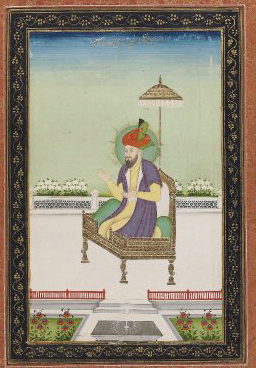
The Chagatai Khanate, or Chagatai Ulus was a Mongol and later Turkicized khanate that comprised the lands ruled by Chagatai Khan, second son of Genghis Khan, and his descendants and successors. At its height in the late 13th century the khanate extended from the Amu Darya south of the Aral Sea to the Altai Mountains in the border of modern-day Mongolia and China, roughly corresponding to the area once ruled by the Qara Khitai.
Tughlugh Timur Khan (1312/13–1363) was the Khan of Moghulistan from c. 1347 and Khan of the whole Chagatai Khanate from c. 1360 until his death. Esen Buqa is believed to be his father. His reign is known for his conversion to Islam and his invasions of Transoxiana.
Ahmad Alaq was the Khan of Eastern Moghulistan from 1487 to 1504. He was the second son of Yunus Khan. His mother was Shah Begum, fourth daughter of Badakhshan prince Lali.
Qutlugh Nigar Khanum was the first wife and chief consort of Umar Shaikh Mirza II, the ruler of Ferghana Valley. She was a princess of Moghulistan by birth and was a daughter of Yunus Khan, the Great Khan of Moghulistan.
Dost Muhammad Khan was Khan of Aqsu in Moghulistan from 1462 until his death. He was the son of Esen Buqa II.
Satuq Khan was first a Chagatai Khan in Timurid Empire set up as nominal Khan by Ulugh Beg and later replaced and sent in 1428 C.E. to overcome Timurid enemies, the Moghuls of Moghulistan by claiming his right as their Khan. He advanced and defeated the unprepared troops of Awais Khan in 1429 C.E. Awais Khan died while trying to cross a stream but was trapped in a quicksand and eventually struck by an arrow in confusion by his own soldier. Thus Satuq Khan became the new Moghul Khan from 1429 to 1434 C.E.

Yunus Khan, was Khan of Moghulistan from 1462 until his death in 1487. He is identified by many historians with Ḥājjī `Ali, of the contemporary Chinese records. He was the maternal grandfather of Babur, founder of the Mughal Empire.
Sultan Mahmud Khan, was Khan of Tashkent and of the Moghuls of western Moghulistan (1487–1508). He was the eldest son of Yunus Khan. He was born in 1464, his mother was Shah Begum, daughter of Badakhshan prince Lali, who claimed his descent from Alexander the Great and gave one of his six daughters to Yunus Khan in marriage, pleasing his request.

Moghulistan, also called the Moghul Khanate or the Eastern Chagatai Khanate, was a Mongol breakaway khanate of the Chagatai Khanate and a historical geographic area north of the Tengri Tagh mountain range, on the border of Central Asia and East Asia. That area today includes parts of Kazakhstan, Kyrgyzstan, and northwest Xinjiang, China. The khanate nominally ruled over the area from the mid-14th century until the late 17th century.
Sultan Said Khan ruled the Yarkent Khanate from September 1514 to July 1533. He was born in the late 15th century in Moghulistan, and he was a direct descendant of the first Moghul Khan, Tughlugh Timur, who had founded the state of Moghulistan in 1348 and ruled until 1363. The Moghuls were turkicized Mongols who had converted to Islam.
Mirza Muhammad Haidar Dughlat Beg was a Chagatai Turco-Mongol military general, governor of Kashmir, and a historian. He was a Mughal Dughlat prince who wrote in both Chaghatai and Persian languages. Haidar and Babur were cousins on their mother's side, through the line of Genghis Khan. Unlike Babur, Haidar considered himself more of an ethnic Mongol of Moghulistan.

Mirza Abu Bakr Dughlat was a ruler in South-Western part of present East Turkistan / Xinjiang Uyghur Autonomous Region of China, an amir of the Dughlat tribe. In the middle of the fifteenth century, in 1465, he founded in Western Kashgaria a kingdom based at Yarkand, a fragment of Moghulistan. It included Khotan and Kashgar; he took Kashgar in 1480. He was the son of Saniz Mirza, son of Mir Sayyid Ali, the latter was amir in Kashgar who regained control of the city by Dughlat dynasty, having expelled Timurid local ruler in 1435.
Saqsiz Mirza was the Dughlat amir of Yarkand from 1457/58 until his death. He was the elder of two sons of Amir Sayyid Ali.
Muhammad Haidar Mirza was the Dughlat amir of Kashgar from c. 1465 until 1480. He was the grandfather and namesake of the historian Muhammad Haidar Mirza (1499/1500-1551).

The Dughlat clan was a Mongol clan that served the Chagatai khans as hereditary vassal rulers of several cities in western Tarim Basin, in modern Xinjiang, from the 14th century until the 16th century. The most famous member of the clan, Mirza Muhammad Haidar, was a military adventurer, historian, and the ruler of Kashmir (1541–1551). His historical work, the Tarikh-i Rashidi, provides much of the information known about the family.
Uwais Khan ibn Sher Ali also referred to as Sultan Vais Khan, was the Moghul Khan of Mughalistan;. He was the nephew of Sher Muhammad. In English, his name has been variously spelled and pronounced as either Awais, Owais or Vais.

Umar Shaikh Mirza II was the ruler of the Fergana Valley. He was the fourth son of Abu Sa'id Mirza, the emperor of the Timurid Empire in what is now Kazakhstan, Uzbekistan, Afghanistan and eastern Iran.

The Yarkent Khanate, also known as the Yarkand Khanate and the Kashghar Khanate, was a Sunni Muslim Turkic state ruled by the Mongol descendants of Chagatai Khan. It was founded by Sultan Said Khan in 1514 as a western offshoot of Moghulistan, itself an eastern offshoot of the Chagatai Khanate. It was eventually conquered by the Dzungar Khanate in 1705.

Aisan Daulat Begum was the first wife and chief consort of Yunus Khan of Moghulistan. She was the mother of Qutlugh Nigar Khanum, and hence the grandmother of the first Mughal emperor, Babur. During the reign of her grandson, she functioned as his de facto regent and advisor, from 1494 to 1505.
Mihr Nigar Khanum was the first wife of Sultan Ahmed Mirza, the King of Samarkand and Bukhara. She was a princess of Moghulistan by birth and was the eldest daughter of Yunus Khan, the Great Khan of Moghulistan and his chief consort Aisan Daulat Begum. She was also the aunt of Emperor Babur, the founder of the Mughal Empire of India as well as its first Emperor.








